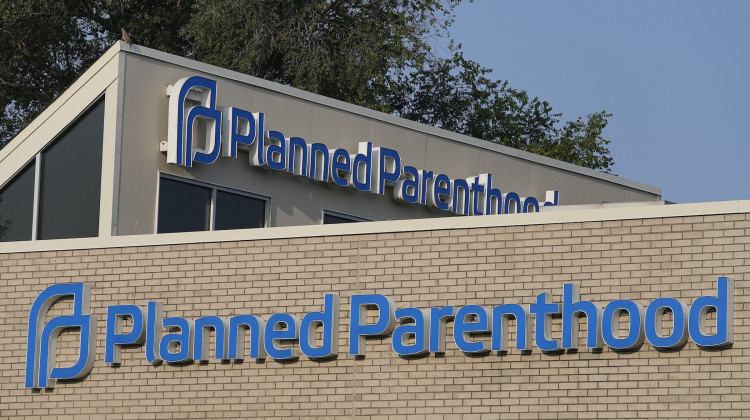
A "stop the spread" poster in Burmese designed by the Centers for Disease Control and Prevention.
Centers for Disease Control and PreventionAs national and state leaders struggle to get COVID-19 under control, minority groups are at a higher risk for the virus. And that includes Indianapolis’ Burmese refugees, a tight-knit community. But providing these refugees with accurate information about the virus has been a challenge for public health workers.
Drive along the neighborhoods on Indianapolis’ southside and it’s hard to miss the international grocery stores, Burmese restaurants, and Chin-Christian churches. The city is home to an estimated 15,000 to 20,000 Burmese refugees, and on the south side, most of them are Chin, an ethnic group that fled religious persecution in the southeast Asian country of Myanmar.
“It's a very close and tight-knit community,” says Juno Siang, a Burmese community health advocate with the Franciscan Health hospital network.
Siang says it’s difficult to know how bad COVID-19 is in the Indianapolis Burmese community.
“It is very hard to answer those questions because, you know, cultural beliefs and values become a big portion of discussing this issue,” Siang says. “It is kind of regarded almost like a taboo to talk about.”
Kate Hill-Johnson, administrative director of community health improvement for Franciscan Health, says rising case counts could be due to more testing, but it’s difficult to know for sure.
“Is there an uptick? It kind of sounds like it based on stories that are going through the communities.” she says. “Do I have hard data on that? No.”
She says Burmese refugees often avoid going to the doctor until it’s necessary.
“I think … it's not a matter of if but when,” Hill-Johnson says. “And how significant does it become, given these cultural challenges, to treating something like a pandemic?”
One of the biggest barriers to providing accurate information about COVID-19 is that not all Burmese refugees are fluent in English. This means some struggle to make sense of the pandemic through traditional media.
Also, in Indianapolis there are multiple dialects of Chin languages, with Hakha-Chin the most common. And concepts like social distancing, which were new for most Americans in March, can be lost in translation.
The Chin Languages Research Project, based out of Indiana University, has been working to translate COVID-19 documents into Hakha-Chin.
Peng Hlei Thang, a recent IU grad, has been working with the project for several years.
“Well we try to make it as simple as possible, for socially distancing we simply said, ‘Stay six feet away.’ Contact tracing — it’s hard to translate those kinds of terms, so it’s been challenging.” Thang says. “We just try as best as we could to make it understandable for our audience.”
However, many of the refugees worked as farmers in remote areas of Myanmar, and aren’t literate in the regional language, Siang says.
This means information has to be communicated verbally, a challenge during times that require social-distancing to stem the spread of COVID-19.
For a long time, churches have served as a mainstay of information in the Chin-Burmese community, and services would often begin with community announcements. But with church services moving online, it presents a challenge for people without internet or technology skills.
“Everything in the community is like, really, really kind of like based on gossip and rumors currently,” Siang says. “A lot of unnecessary fear is spreading around the community.”
In June, the Marion County Public Health Department told Side Effects there was a COVID-19 outbreak in the city’s Burmese community. A few weeks later, they walked this statement back saying they don’t have specific demographic data.
The department did recently open a southside testing site, near a prominent Burmese community association.
“The other challenge that we are seeing is that we are not following the quarantine rules because we don't understand the system, how it works,” says Van Uk, who works for Windrose Health Network, a federally funded health center on the southside.
Uk says recently there’s been more willingness from Burmese refugees to seek testing for COVID-19. But all the new rules of the pandemic have proved confusing.
“So for example, you know, if someone is supposed to be quarantined, and they need to be seen by the doctor, instead of calling the doctor office they will show up in person,” Uk says.
People in the Burmese community say fear also has kept some refugees from speaking up if they think they could be sick. Some people have reported harassment for being Asian, others fear losing their jobs or being the center of rumors and gossip.
Uk works closely with churches to help spread reliable information about COVID-19. “So, we need those people to give them the courage ... ‘Hey, it's okay to let your doctor or your pastor, to let them know that you have COVID-19 symptoms. That way we can help you.’”
This story was produced by Side Effects Public Media, a news collaborative covering public health.
 DONATE
DONATE






 Support WFYI. We can't do it without you.
Support WFYI. We can't do it without you.